The best two-week USA itinerary
If you are like me, the ultimate road trip in my mind is a 2-week USA itinerary.
If you have two weeks to spare, here is my ideal itinerary to see the best of everything, without rushing!
Two-week road trip map in the American West
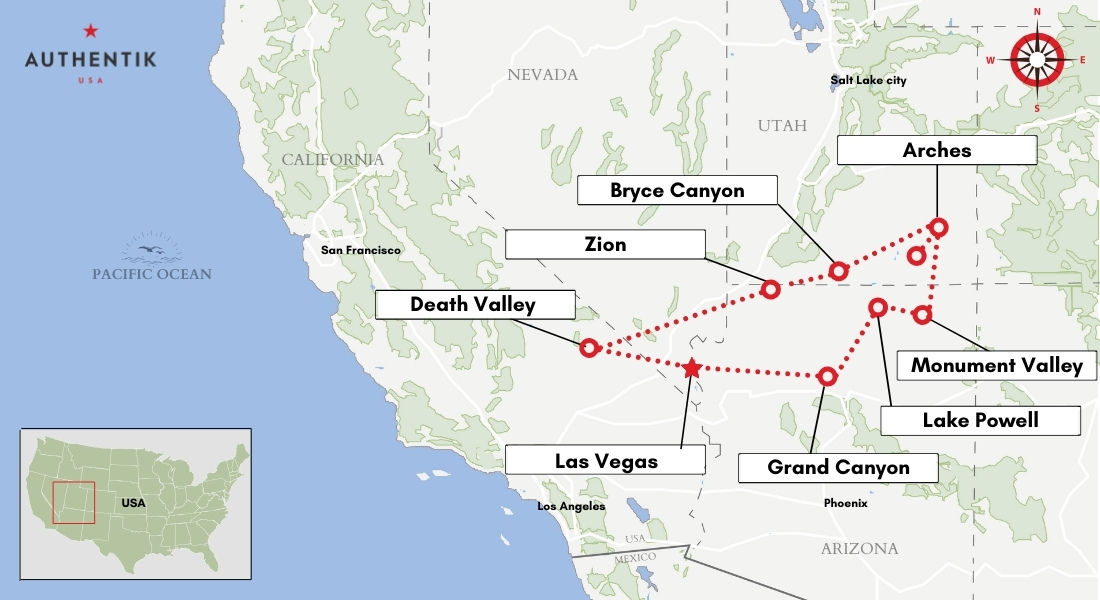
Summary of the American West tour
Detailed itinerary
Days 1-2: Las Vegas
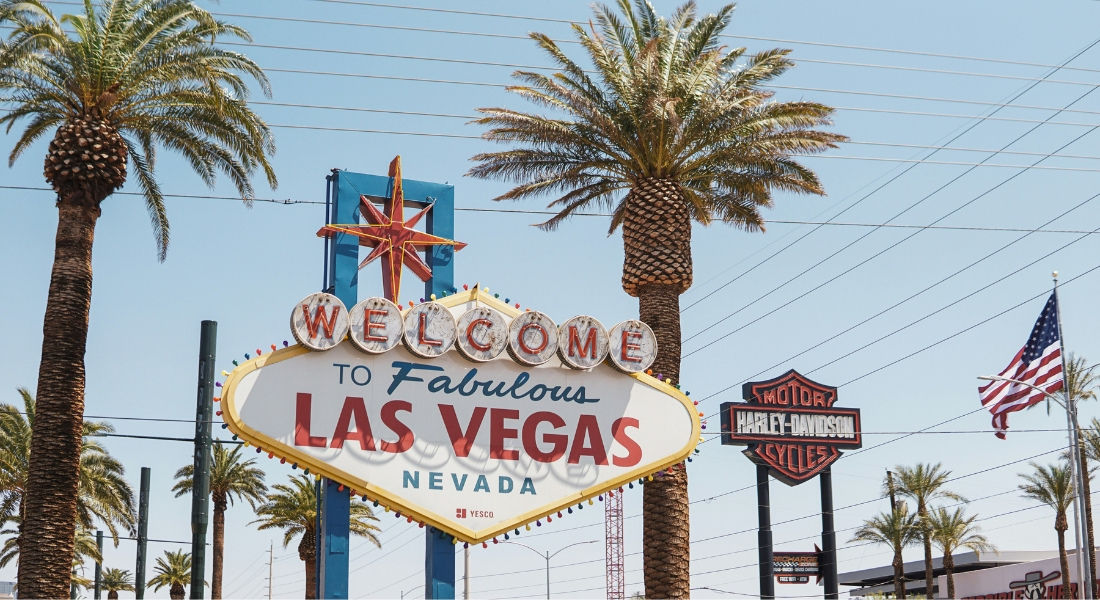
Welcome to Las Vegas, nicknamed "Sin City", is a place where the wildest dreams come true and where exuberance reaches its peak. Upon your arrival, start with a must-see visit to the famous "Welcome to Fabulous Las Vegas" sign, located at the southern end of the Strip. This iconic symbol of the city, created in 1959, is a must for anyone wanting to immortalize their stay. Did you know that this sign was designed by Betty Willis, one of the few women in the neon design industry at that time? Once you've taken your photos, you will be ready to dive into the excitement.
From there, head to the Mandalay Bay Resort & Casino, home to the Shark Reef Aquarium, one of the largest aquariums in North America. With its 2,000 marine creatures, including 15 different species of sharks, this place is perfect for discovering marine life. The aquarium even has an underwater tunnel, offering a 360-degree view of the fish and sharks swimming above you. After exploring this marine environment, relax on the resort's artificial beach, in the heart of a green setting that feels far from the surrounding desert.
At noon, take a gourmet break at the Burger Bar, also located at Mandalay Bay. This restaurant, led by famous chef Hubert Keller, offers a unique experience with burgers made from bison meat or vegetarian options for those looking for something different. After your lunch, head to Paris Las Vegas to admire the miniature replicas of the City of Light's monuments. Stroll under the replica of the Eiffel Tower, a monument rising to 165 meters – half its original size. It's not just a backdrop; you can also go to the top for a breathtaking view of the city. Inside, the hotel recreates the ambiance of a Parisian street, with street lamps and romantic bridges.
In the late afternoon, walk to the Bellagio, one of the city's most famous hotels. This hotel is inspired by the Italian town of the same name near Lake Como. Behind its reception adorned with magnificent glass flowers created by Dale Chihuly, lies a breathtaking conservatory where floral arrangements change with each season. But it is in front of the hotel, where the large artificial lake is located, that the main attraction unfolds: the Bellagio Fountain Show. This show, synchronized with classical music and contemporary hits, is a magical experience you won't want to miss.
End your first day with a visit to the STRAT. This 350-meter high tower, built in 1996, dominates the Strip and offers a stunning view of the city's sparkling lights. It is also here that you will find some of Vegas's most thrilling attractions, suspended outside the tower. Will you dare to ride the Big Shot, an attraction that propels you at a crazy speed 50 meters above the top of the tower? You will literally be on top of Vegas, enjoying a breathtaking view.
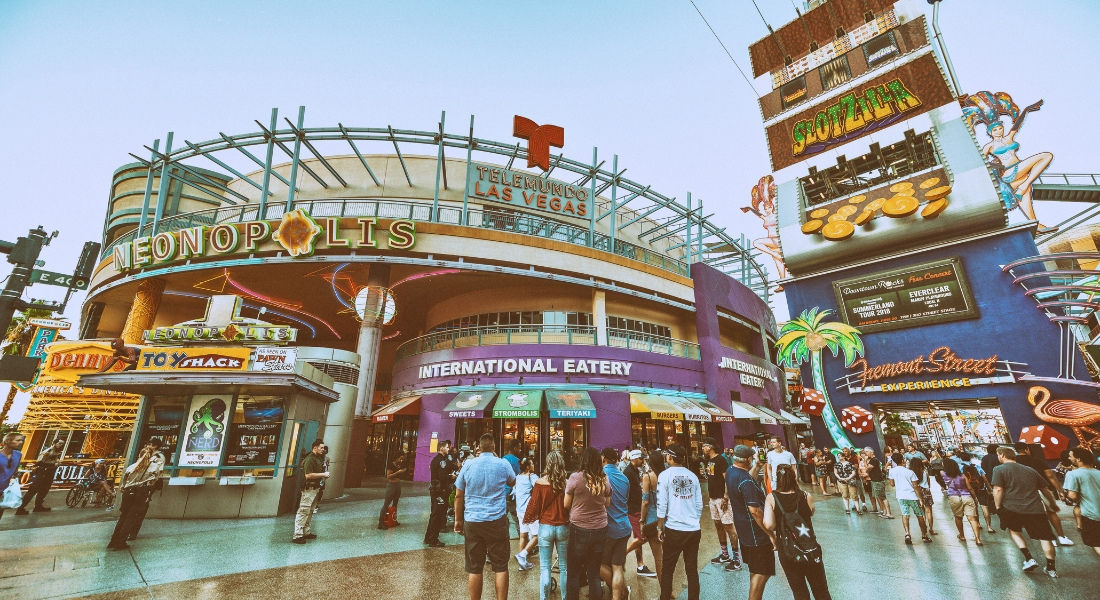
The second day of your stay starts with a morning dedicated to fun at Circus Circus. The hotel houses the AdventureDome, an indoor amusement park covering nearly 20,000 square meters. With its roller coasters, arcade games, and children's rides, it's the perfect place for family entertainment.
At noon, head to Caesars Palace, another Las Vegas landmark, to have lunch at the Cheesecake Factory. This establishment is famous for its generous portions and 50 varieties of cheesecakes. After eating, a walk to the Wynn is a must. This luxury hotel complex is surrounded by a beautiful artificial lake and lush gardens, offering a haven of peace in the heart of the city's hustle and bustle.
In the evening, why not try the Asian restaurant Red 8 for a unique culinary experience? You can enjoy dishes inspired by China, Thailand, Vietnam, and many other Asian countries, in a setting that is both sophisticated and relaxed.
To end your stay in Las Vegas in style, head to Fremont Street, in the historic heart of the city. This is where the story of Vegas began with the Golden Gate Hotel & Casino, opened in 1906. Today, Fremont Street is known for its Viva Vision screen, the largest LED screen in the world, 457 meters long. At night, this screen broadcasts light shows accompanied by music, creating an electric atmosphere you won't find anywhere else.
Fremont Street also hosts free concerts and special events throughout the year. It is said that it is on this street that the expression "What happens in Vegas stays in Vegas" was born. It's not surprising when you think of everything that happens here!
Days 3-4: Grand Canyon (436 km)
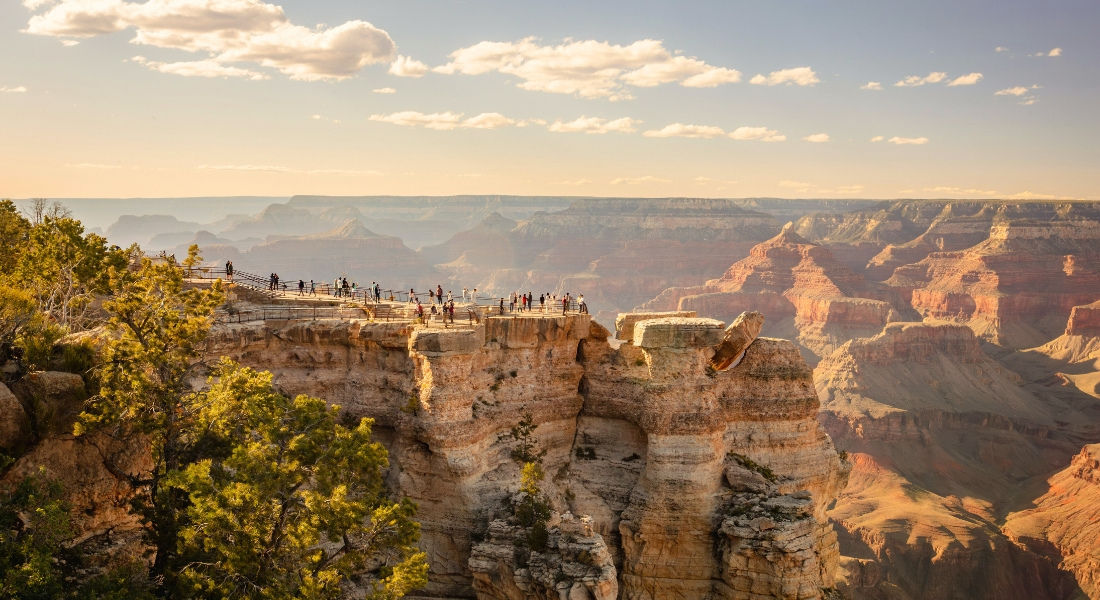
It is now time to hit the road! Pick up your rental car in Las Vegas, and set out on your adventure. Your first stop needs no introduction, the Grand Canyon! This national park, a UNESCO World Heritage Site, has attracted travelers from around the world since its establishment in 1919.
I recommend leaving early in the morning to avoid the crowds and immerse yourself directly into the historic heart of the Grand Canyon Village, a place steeped in history. The village is home to iconic buildings dating from the early 20th century, such as the famous El Tovar Hotel, opened in 1905, which remains one of the most luxurious hotels in the park today. This place has hosted famous personalities, such as Theodore Roosevelt, and its dark wood lobby reflects the elegance and grandeur of a bygone era. Right next door, the Hopi House is another historical gem. Inspired by the architecture of the indigenous Hopi people, this house is a vibrant tribute to the ancient cultures that inhabited the region long before the Grand Canyon became a national park.
From the village, it's easy to join the Rim Trail, a hiking trail that runs along the canyon's edge for more than 20 km. It offers breathtaking views of this immense gorge, and you can explore it on foot or using the park's free shuttle service. Not far from your starting point, you'll reach Mather Point, one of the most impressive viewpoints of the canyon. The contrast between shades of red, orange, and purple at sunrise is simply unforgettable.
Continue your journey to other must-see viewpoints like Maricopa Point, Hopi Point, and Mohave Point, each offering different perspectives on this vast rocky expanse. You can get off the shuttle at each of these points and soak in the vastness of the canyon while admiring the erosive power of the Colorado River at the canyon's bottom.
For lunch, stop at Fred Harvey Burger, a family restaurant located in the Grand Canyon Village. It offers simple and tasty dishes, perfect for recharging after a morning of walking. If you prefer a lighter option, the Bright Angel Fountain is an excellent alternative with its coffees, sandwiches, and ice creams.
In the afternoon, take the Desert View Drive, a picturesque 40 kilometer road east of the Grand Canyon Village. Along the way, you'll stop at spectacular viewpoints like Grandview Point, where you can enjoy a 180-degree panoramic view of the canyon, and Lipan Point, overlooking the Unkar rapids of the Colorado River. The road ends at Desert View, where there is a historic stone tower offering a 360-degree view of the canyon. This spot is particularly prized for observing spectacular sunsets when the canyon walls are bathed in warm colors.
In the evening, for a more refined dining experience, head to the Arizona Steakhouse, where you can enjoy delicious steaks and other typical regional dishes while admiring an impressive view of the canyon.
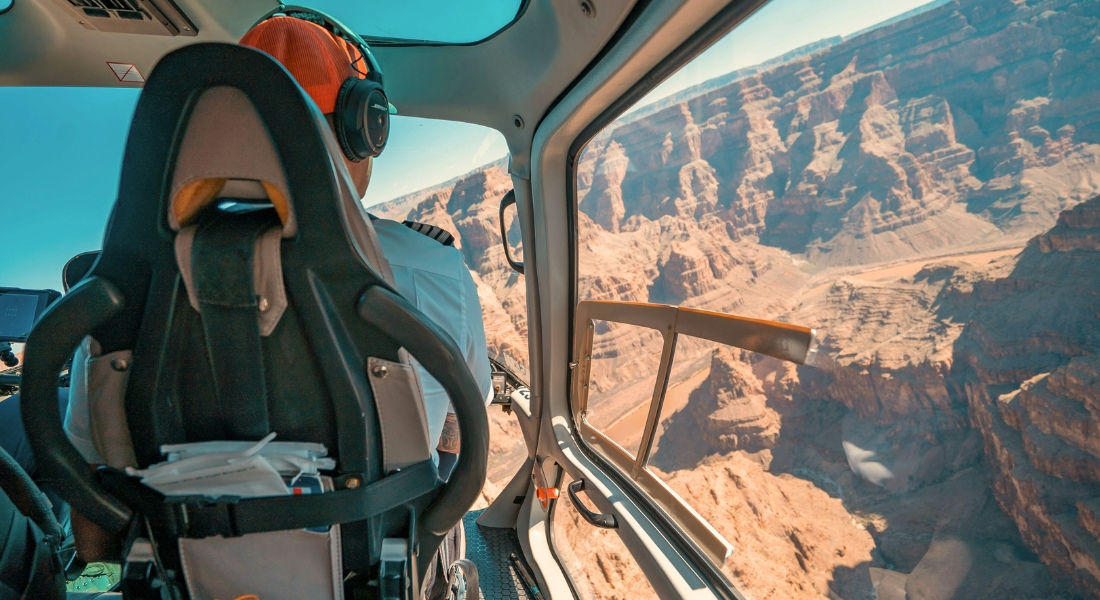
For the second day of your visit to the Grand Canyon, opt for the ultimate experience: a helicopter flight over this natural wonder. From the air, you will be amazed by the panoramic view of the canyon, from the South Rim to the North Rim, a wilder and much less visited region. It's one of the rare opportunities to truly appreciate the gigantic size of the canyon, with its multicolored rock formations stretching as far as the eye can see.
After this spectacular flight, return to solid ground to further explore the South Rim. Take the Rim Trail again, focusing on less frequented but equally impressive viewpoints. If you're an experienced hiker, you might attempt a partial descent into the canyon via the Bright Angel Trail, a popular trail that allows you to descend into the gorge and discover the canyon from a different angle. Don't forget to bring plenty of water, as temperatures can be extreme, even in spring and autumn.
To end your visit on a high note, treat yourself and book a memorable last meal at the El Tovar Dining Room!
CAR RENTAL COMPARATOR FOR A TOUR IN THE AMERICAN WEST
Day 5: Lake Powell (200 km)
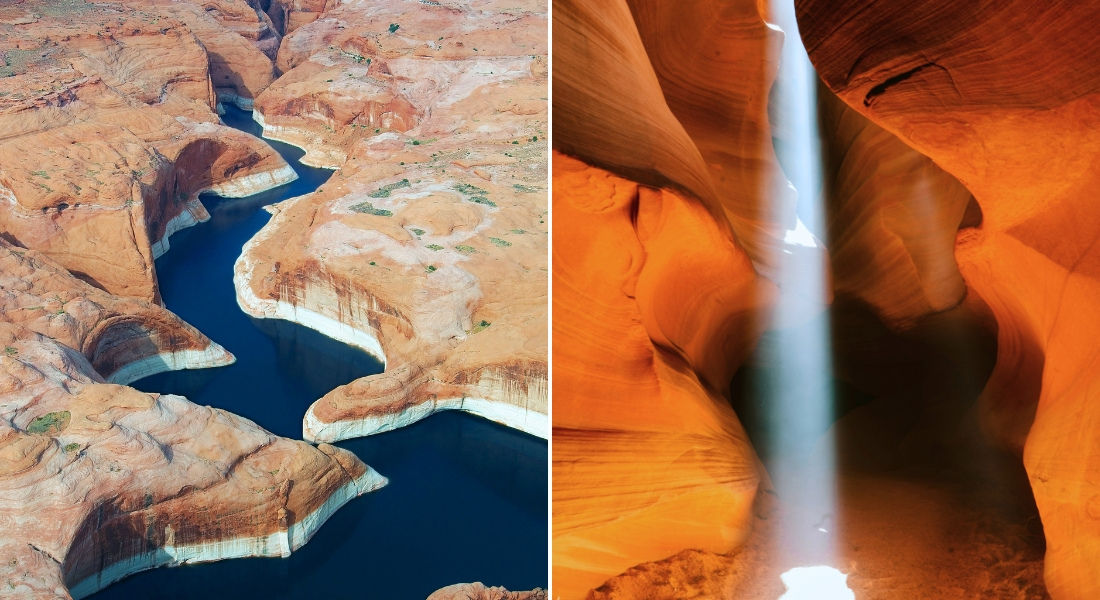
Today, head to Lake Powell! Start your discovery with a visit to the Glen Canyon Dam, located near the town of Page. From the Carl Hayden Visitor Center, enjoy panoramic views of the 216-meter dam and Lake Powell. The guided tour will let you discover the fascinating history of this structure that transformed the area.
Next, head to Antelope Canyon, one of the most photographed sites in the world. Choose between Upper Antelope Canyon, where light penetrates and illuminates the rock formations at midday, or Lower Antelope Canyon, a more intimate underground experience. Both options require a prior reservation, especially during high traffic periods.
Then, I recommend taking a cruise on Lake Powell. Navigating this vast lake is one of the best ways to admire the surrounding landscapes. If the weather permits, opt for a cruise to Rainbow Bridge, the world's largest natural bridge.
If you get hungry, take a break at Big John’s Texas BBQ to savor grilled meat in a festive atmosphere before continuing your adventure.
End your day with a visit to the famous Horseshoe Bend, a horseshoe-shaped bend of the Colorado River. After a 20-minute walk, you'll be rewarded with a spectacular view of this iconic site, ideal for memorable photos at sunset.
Day 6: Monument Valley (278 km)
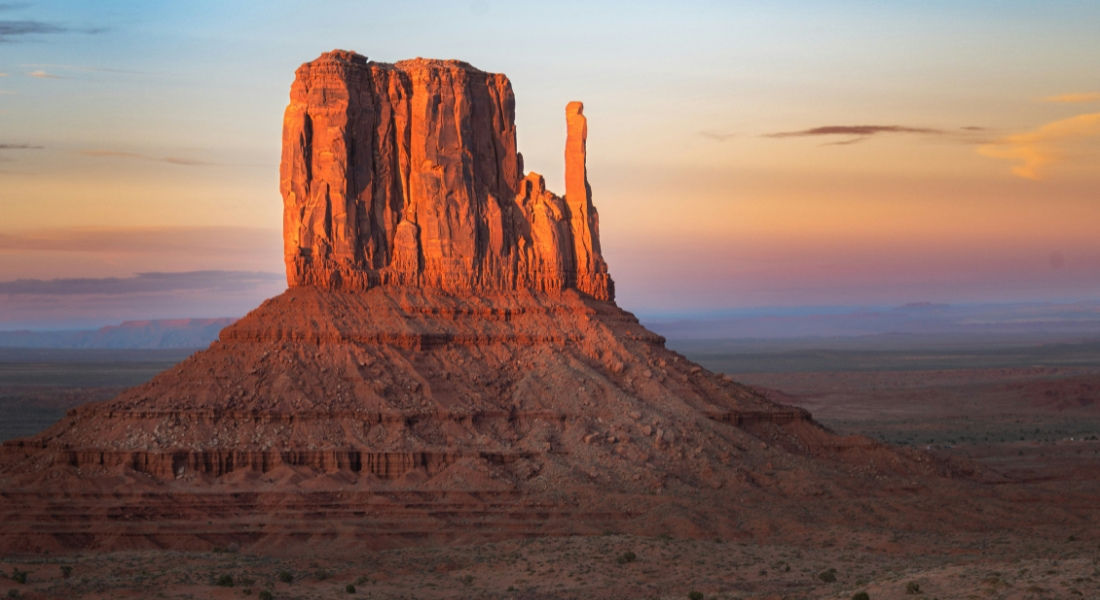
The road continues to another must-see of the West, Monument Valley. A significant part of the Navajo Nation territory, visiting Monument Valley is a unique experience that immerses you in an iconic American landscape.
Start your day by heading to the Visitor Center. It's an essential starting point to learn more about Navajo culture, and you can find brochures and maps to plan your visit. It is also the perfect place to buy local crafts and even have a meal before exploring.
Next, take the Monument Valley Scenic Drive, a 27-kilometer road that takes you to the heart of legendary rock formations. However, this unpaved road can be challenging to access for small vehicles. If you have a suitable car, you can discover spectacular sites like John Ford Point, named after the famous Western director, or the formations known asThree Sisters, Camel Butte, and Elephant Butte. Each viewpoint offers different perspectives on this reddish valley. If you prefer not to drive on this bumpy road, book a guided 4X4 tour with a Navajo guide at the Visitor Center, or even a horseback excursion for an even more authentic experience.
You might also choose to negotiate a private tour with a Navajo guide for the afternoon. These local guides offer more in-depth tours of the valley and can tell you fascinating stories about the region. Do not hesitate to engage in conversation with them to learn more about Navajo culture and the history of Monument Valley.
End your day by returning to John Ford Point or staying at the Visitor Center to admire the sunset. When the golden evening light bathes the buttes of Monument Valley, the reds become more intense, and the spectacle is simply unforgettable. This magical moment is perfect for photographers, as the rock formations take on even more vibrant hues.
Days 7-8: Arches (162 km)
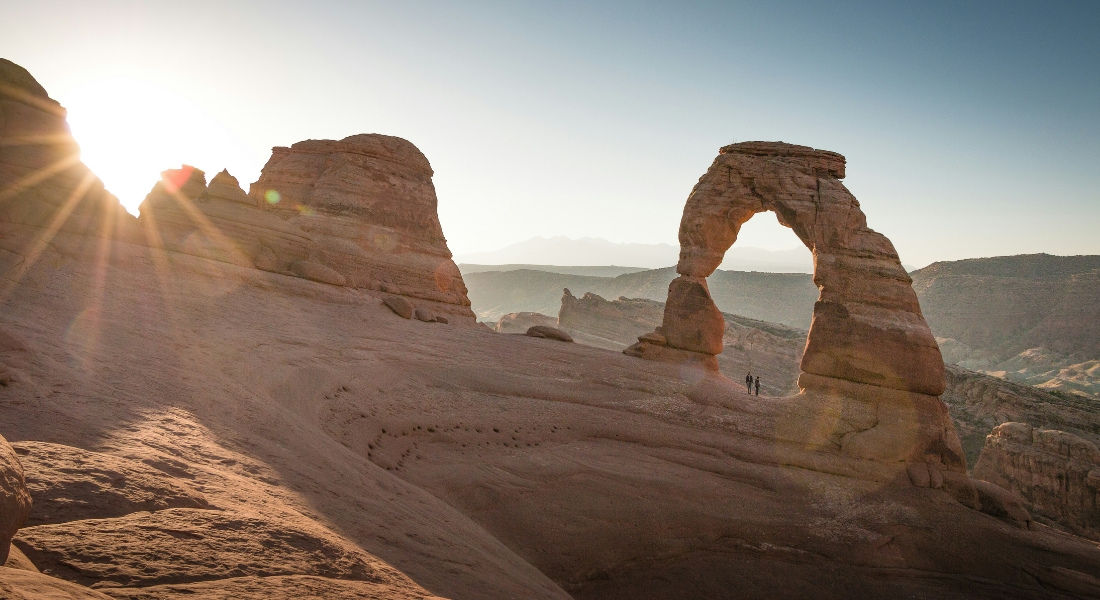
After exceptional places, you hit the road today for a national park, Arches. Start with a visit to Park Avenue, an impressive rock formation that evokes a street lined with giant sandstone buildings. This place has been a setting for films like Indiana Jones and Thelma and Louise, making your 3.2 km walk even more fascinating. You will feel transported to the heart of a mythical western while admiring these spectacular landscapes.
Next, head to the Windows Section after passing Balanced Rock, a huge rock precariously balanced, emblematic of the power of nature. Here, short hikes will take you to Double Arch, an astonishing formation consisting of two connected arches. It is one of the largest arches in the park, measuring nearly 45 meters in height.
At the end of the day, prepare for the must-do hike to Delicate Arch, the most famous in the park. This moderate 4.8 km hike rewards you with a view of the arch under the golden light of sunset. This solitary arch, often used as a symbol of Utah, stands 16 meters high and is the most photographed in the park. If you prefer a less demanding route, the Lower and Upper Delicate Arch viewpoints offer an alternative to observe this natural wonder without hiking the entire trail.
After this first day of exploration, a dinner at Sunset Grill, located atop a cliff with an amazing view of Moab, is a must. This restaurant used to be the home of a local millionaire, and today, it offers a unique setting to enjoy a meal while watching the sunset over the valley.
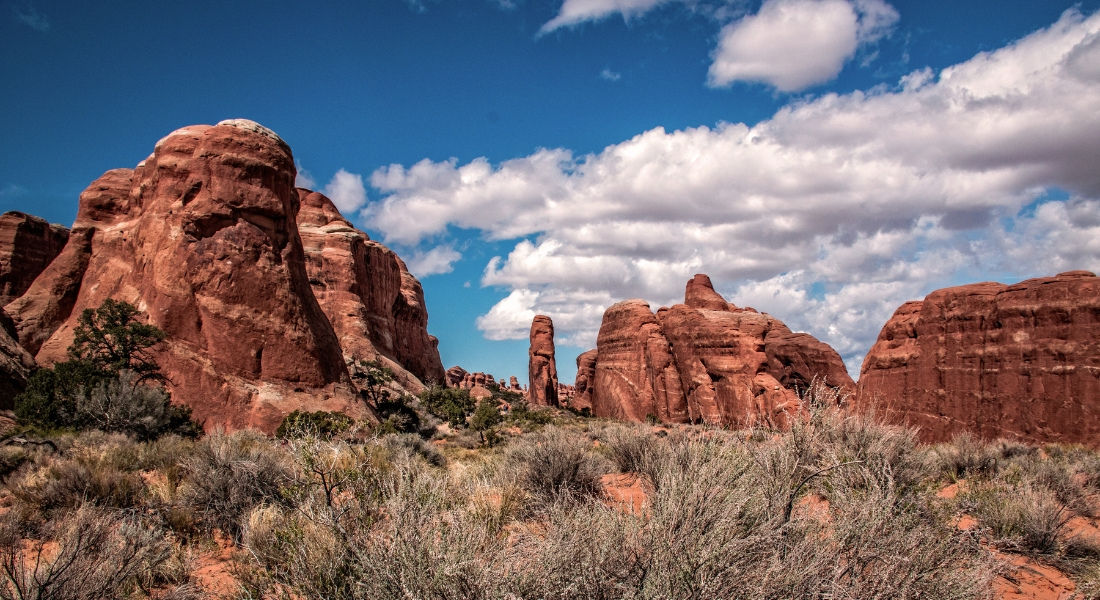
The second day, head to Devil's Garden, a can't-miss spot in the park. Here you'll find Landscape Arch, one of the world's longest natural arches with its 90-meter span. This easy hike allows you to admire this impressive arch, which almost seems suspended in the air, ready to collapse at any moment. For more experienced hikers, the trail continues to Dark Angel and the Primitive Loop Trail, where you can discover up to eight different arches. It is best to explore this area early in the morning to avoid the heat, which can soar in summer.
Midday, a stop at Quesadilla Mobilla, a popular food truck in Moab, is perfect for a tasty lunch break. The homemade quesadillas are appreciated for their fresh ingredients and bold flavors. After this gourmet stop, prepare for the adventure at Fiery Furnace. This natural maze of canyons and cliffs, 3.2 km long, offers a unique and challenging hiking experience. With its narrow passages and impressive views, it’s a challenge to be undertaken with a ranger guide for more safety, especially if you want to learn more about the complex geological formation of the area.
To conclude your stay, head to Desert Bistro in Moab. This gourmet restaurant is renowned for its inventive cuisine with southwestern influences, a real treat to end your adventure in the Utah desert.
Day 9: Excursion to Canyonlands
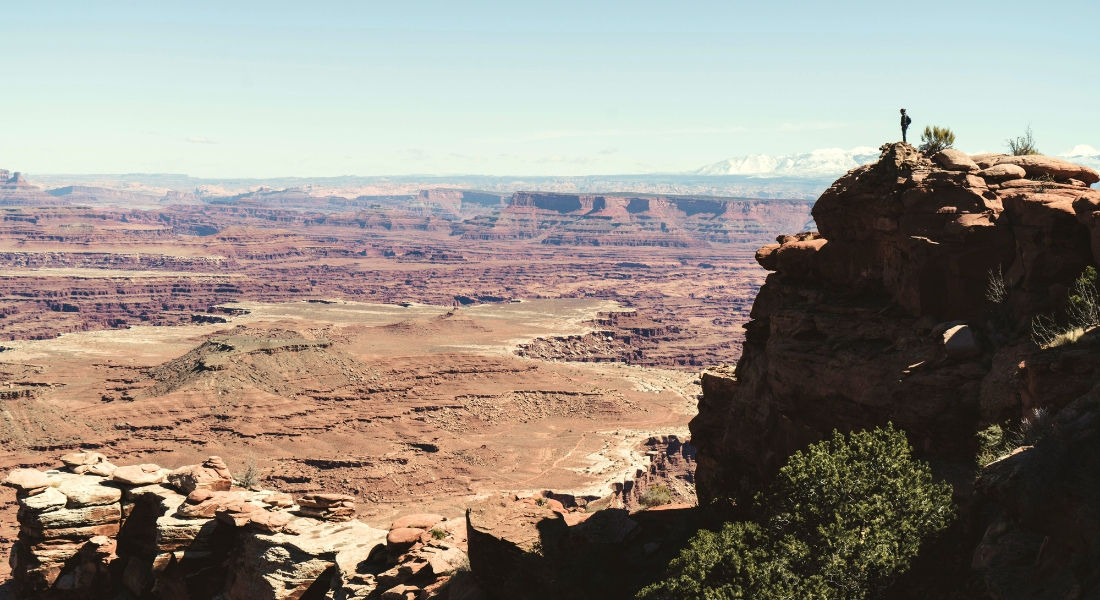
For your last day around Moab, explore Canyonlands National Park, with its 1,360 square kilometers of spectacular landscapes. The park is a must-visit destination for nature lovers and wilderness enthusiasts. Located at the heart of the Colorado plateau, the park offers a diversity of breathtaking panoramas, from rocky spires to vast canyons. For a full day, focus your visit on the Island in the Sky section, the most accessible from Moab and renowned for its dizzying viewpoints.
Start your day early by entering the park through the Island in the Sky Visitor Center to get information and a map of the area. Island in the Sky gets its name from the elevated position of this immense mesa, between 1,800 and 1,900 meters in altitude, offering breathtaking views of the canyons carved by the Colorado and Green rivers. First, head to Mesa Arch, a short 1 km round-trip hike that only takes 20 minutes. This natural arch perfectly frames the landscape below, offering one of the most photographed views in the park, especially at sunrise when the light illuminates the arch with a golden glow.
Continue your exploration at the Shafer Canyon Overlook, where you will have a spectacular view of the Shafer Trail, a winding road once used by cowboys and miners. This road, which you can also travel by 4x4 or on foot, is a true challenge for adventurers. The contrast between the steep road and the glowing cliffs will leave you speechless. Before venturing onto the Shafer Trail, be sure to consult a ranger to check the conditions, as the road can be dangerous.
Next, head to Grand View Point Overlook, one of the most impressive viewpoints in the region. From there, you can admire canyons that stretch as far as the eye can see, creating a true labyrinth of red rock formations. This viewpoint is the perfect place to grasp the vastness of Canyonlands and the complexity of its terrain, sculpted by millions of years of erosion. The depth and scale of the canyons visible from this spot are simply incredible.
At the end of the day, if you still have time, make a detour to Dead Horse Point State Park, located just a 10-minute drive from Island in the Sky. This park offers a spectacular view from Dead Horse Point Overlook over the meanders of the Colorado River, with a panorama that rivals the most beautiful in the world. The park's name comes from a legend that cowboys left horses to die of thirst here, unable to reach the river they could see below. The final scene of the film Thelma & Louise was also filmed here, adding a cinematic touch to this already mythical place. It's a great spot for sunset!
Days 10-11: Bryce Canyon (397 km)
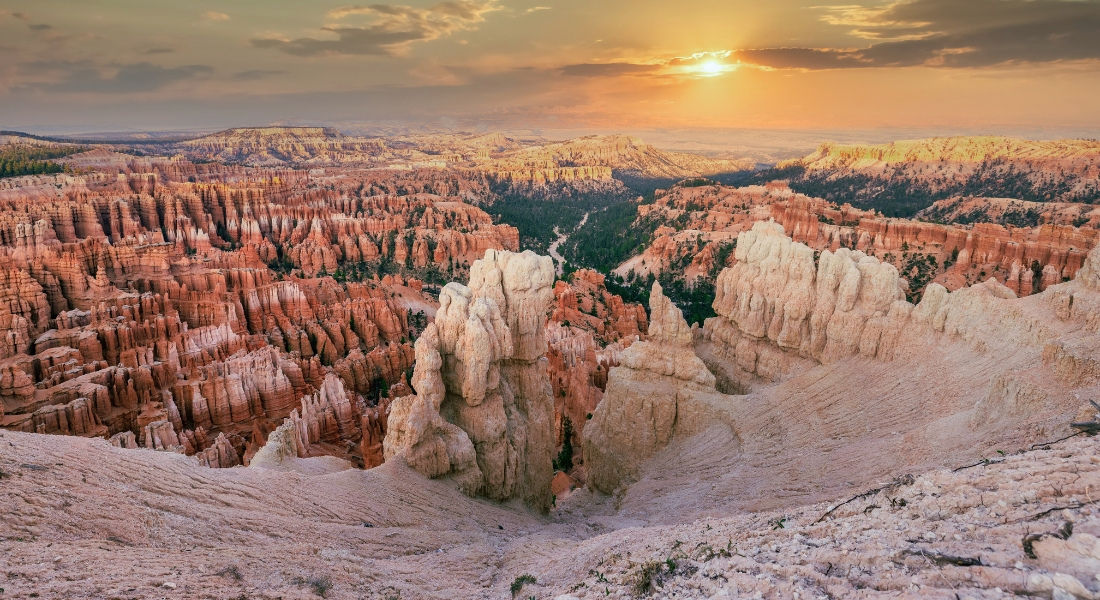
Your next destination is Bryce Canyon National Park, where hundreds of rock spires and needles, known as Hoodoos, form a spectacular natural amphitheater. Ebenezer Bryce, a pioneer who settled there with his family in 1875, described this place as "a hell of a place to lose a cow," a phrase that sums up the rugged nature of this terrain. Today, the park bears his name in homage to his exploration and settlement of the area.
Head directly to Sunrise Point, one of the most spectacular viewpoints in the park. As its name suggests, this place is perfect for watching the sunrise if you're an early riser. The morning light illuminates the Hoodoos, those stone spires that seem to catch fire under the golden light. It's a breathtaking view that will immediately immerse you in the unique ambiance of Bryce Canyon.
After appreciating this magical moment, take the Queen’s Garden Trail from Sunrise Point. This easy 2.9 km round-trip trail plunges you into the heart of the park, winding through a forest of Hoodoos. Along the way, you'll discover the rock formation known as Queen Victoria, a Hoodoo that, with a bit of imagination, resembles the famous British queen.
Midway, you can choose to continue your hike by taking the Navajo Loop Trail, a trail that brings you back to Sunset Point. This viewpoint offers a different perspective on the amphitheater, with colors that change throughout the day. Enjoy the morning tranquility to capture photos or simply soak in the natural beauty of this place.
For lunch, head back to the Lodge at Bryce Canyon, located nearby. This mountain lodge-style restaurant offers a warm atmosphere, with dishes made from local and organic products.
In the afternoon, continue your exploration by taking the park shuttle to Inspiration Point. This viewpoint lives up to its name, offering breathtaking panoramas of the rows of Hoodoos stretching southward. If you're in the mood for more walking, the Rim Trail starts from Inspiration Point and follows the edge of the amphitheater to Bryce Point. This easy one-hour hike will lead you to one of the highest and most impressive viewpoints in the park, peaking at 2,528 meters (8,293 feet).
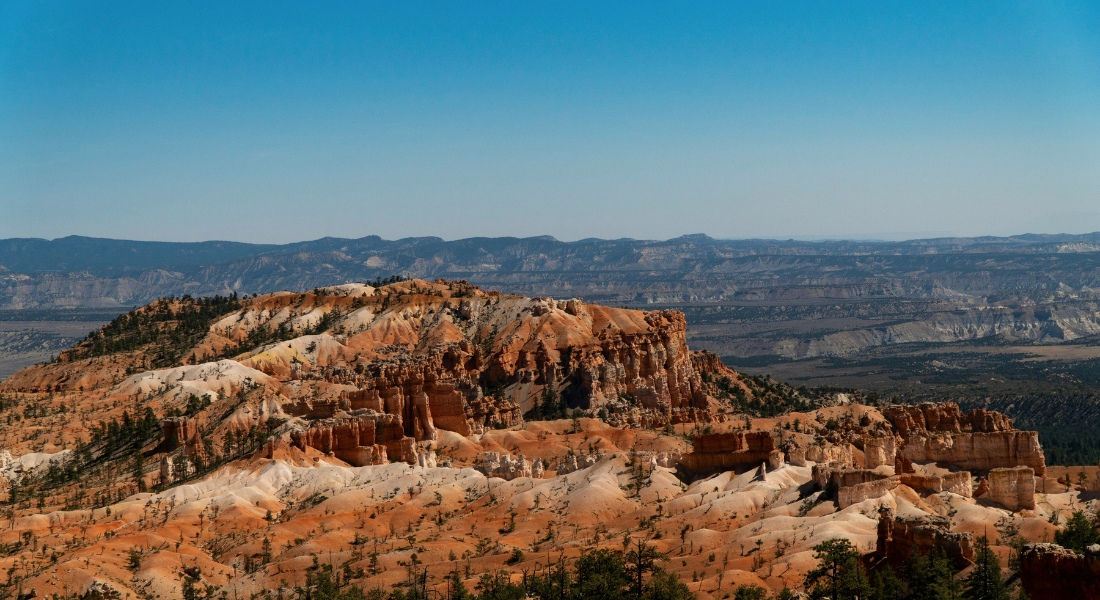
On the second day, start with a visit to the Visitor Center to learn more about the geology, wildlife, and history of Bryce Canyon. This will give you valuable context for the rest of your exploration. Then, take the shuttle to Fairyland Point for a less crowded but equally impressive hike. The Fairyland Loop Trail is a 12.8 km (8 mi) trail that takes you through spectacular landscapes, away from the crowds. This hike is more demanding, but it offers a different perspective on the rock formations, with stunning views of the park.
After this morning hike, head back to the Lodge for lunch or, if you prefer, bring a picnic and enjoy an outdoor meal in one of the park's picnic areas. Bryce Canyon is an ideal place to relax and admire nature while enjoying a simple meal.
In the afternoon, head to Mossy Cave Trail, located outside the park's main area. This easy 1.2 km (0.7 mi) trail leads you to a small mossy cave and a waterfall, offering a refreshing contrast to the arid landscapes of the rest of the park. It's a perfect hike for those looking for something lighter after the long morning walk.
In the late afternoon, if you still have energy, return to Sunset Point for one last view of the canyon, or explore other viewpoints like Paria View or Rainbow Point, accessible by car.
For dinner, head out of the park and go to Stone Hearth Grille in Tropic, about a 20-minute drive from Bryce. This restaurant offers a fine dining experience, with poultry, beef, and seafood dishes, accompanied by delicious homemade sauces. The view from the terrace is just as impressive as the cuisine, providing a perfect setting to end your stay at Bryce Canyon.
Days 12-13: Zion (216 km)
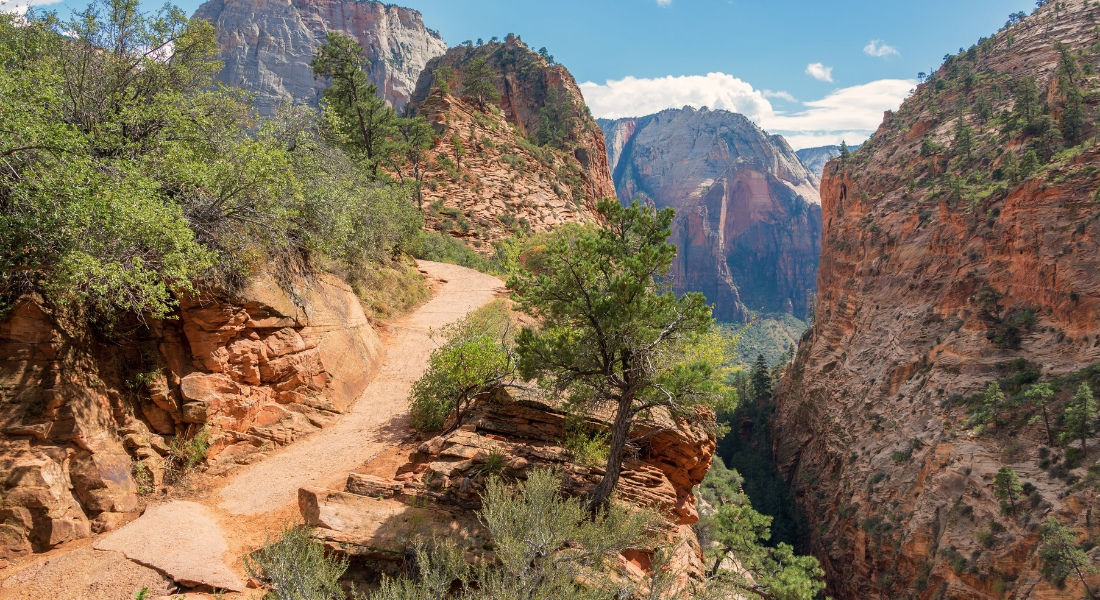
The next park to discover is Zion, where you will be amazed by the contrast between the green ash and poplar trees lining the canyon and the immense sandstone monoliths with colored strata, ranging from white to bright red. Start your day early by taking the free shuttle from the Zion Canyon Visitor Center to the The Grotto stop, the starting point of the famous Angels Landing hike. This 8 km round-trip trail, known to be one of the most impressive in the park, is reserved for experienced hikers due to its steep elevation gain and narrow sections. However, the 360-degree panoramic view of Zion Canyon from the summit is worth every effort.
After descending Angels Landing, take a well-deserved break at the Red Rock Grill located at Zion Lodge. This restaurant offers breathtaking views of the surrounding rock formations, with a typically American menu featuring soups, salads, tacos, and burgers.
In the afternoon, take the shuttle to Canyon Overlook Trail. This short 1.6 km trail, located just before the second tunnel on Zion-Mount Carmel Highway, is ideal for a lighter hike after Angels Landing. It offers an exceptional viewpoint over the southern canyon, where you can admire the jagged peaks and the ochre and cream colors of the landscape. This trail is accessible to most hikers, though it is not recommended for those with vertigo.
End your first day by taking the Zion-Mount Carmel Highway at sunset. This 17-kilometer scenic route, which winds through spectacular landscapes at an altitude between 1,130 and 2,700 meters, is even more magical at this time of day. Stop to observe the Checkerboard Mesa, a massive white sandstone formation with a naturally checkered surface. If you are traveling by RV, make sure you have purchased your permit to cross the tunnel safely.
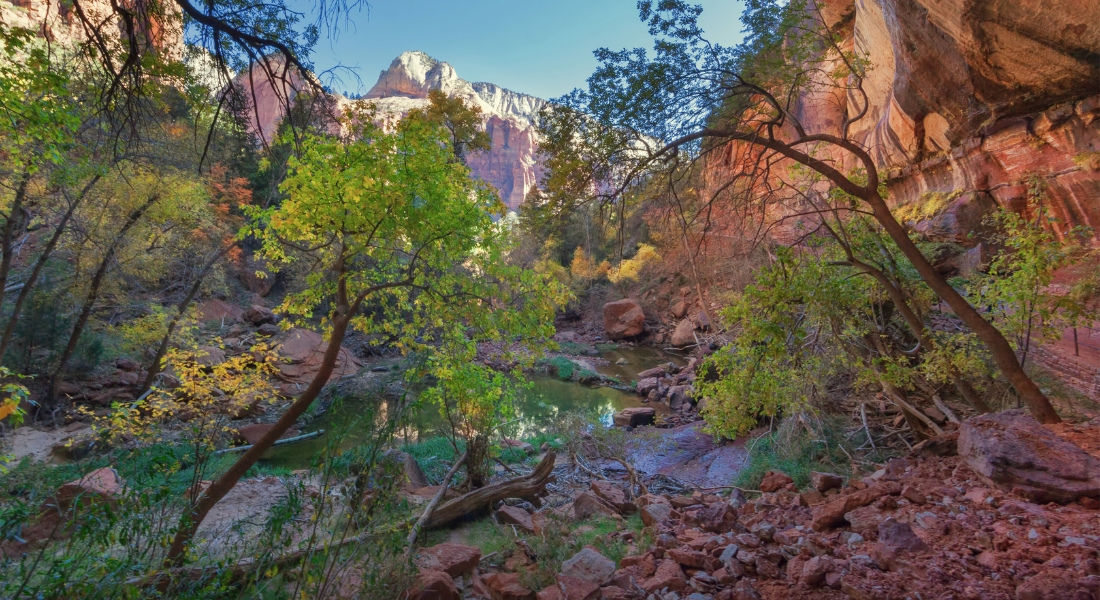
The second day begins with a visit to Court of the Patriarchs, a short but impressive hike that takes you in just 5 minutes to a viewpoint over three majestic sandstone cliffs named Jacob, Isaac, and Abraham. This viewpoint, accessible from the fourth shuttle stop, is an excellent way to start the day with a magnificent perspective on these iconic geological formations.
Next, head to the Emerald Pools Trails, an easy 4.7 km hike that will take you to three different waterfalls: the Lower, Middle, and Upper Emerald Pool. The trail begins at Zion Lodge and leads you through lush vegetation, offering refreshing views at the heart of the park. If you wish to extend the walk, you can take the Kayenta Trail which will lead you to the next shuttle stop, while offering superb views of the canyon and the Virgin River below.
For lunch, return to Springdale and stop at Cafe Soleil, a local favorite for its dishes prepared with natural and organic ingredients.
In the afternoon, experience a memorable adventure by exploring The Narrows, one of Zion's most famous hikes. This hike takes you to the heart of the canyon, where the cliffs narrow to form a passage that you can explore by walking in the Virgin River. The duration and distance you cover depend on your comfort level, but even a short exploration is well worth it. Make sure to wear appropriate shoes, as the riverbed is rocky, and check with the rangers about water conditions before setting off.
To close your stay in Zion, make a final stop at the Spotted Dog Café in Springdale for a quiet dinner. Enjoy the terrace to admire the last light of the day on the surrounding mountains while savoring a delicious meal.
Day 14: Death Valley (427 km)
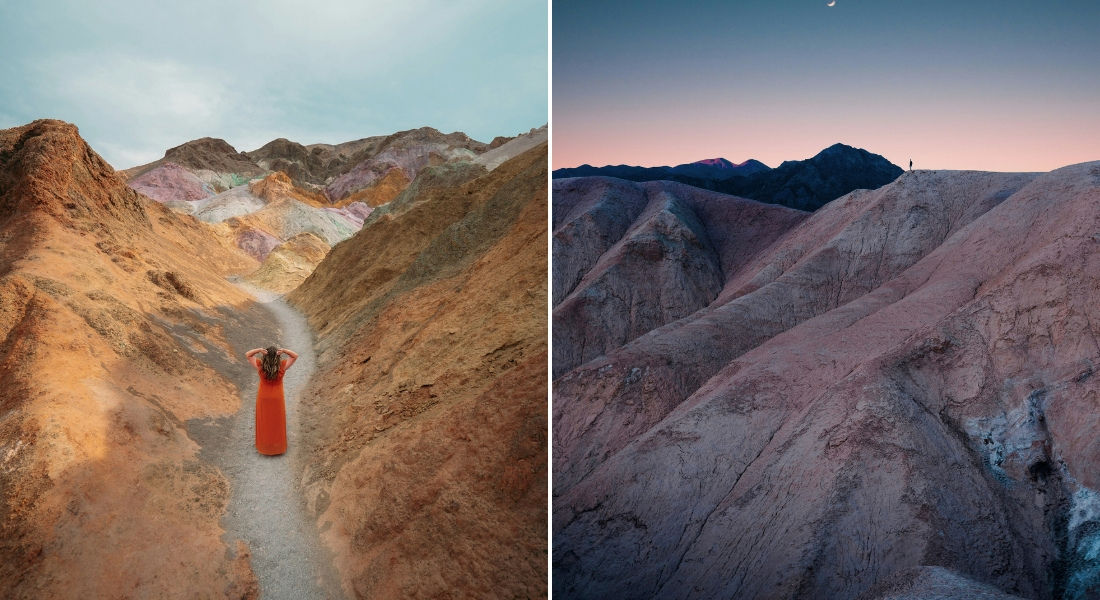
Here you are already at your last destination before returning to Las Vegas, and this one might get you hot! Arrive in Death Valley early to avoid the scorching temperatures, especially in summer. Start at the Furnace Creek Visitor Center to get information and discover the park's fascinating history. Then head to Dante’s View, a viewpoint at 1,500 meters altitude offering spectacular panoramic views over the valley and the Panamint Mountains.
Continue your journey to Zabriskie Point to admire the undulating rock formations with changing colors, particularly impressive at sunrise. Then head down to Badwater Basin, the lowest point in North America, at 86 meters below sea level. This vast expanse of salt flats offers a surreal landscape, with its sparkling salt crystals under the sun.
After exploring Badwater, take the Badwater Road to Artist’s Palette, a remarkable site for its multicolored rocks, the result of metal oxidation. The Artist’s Drive will take you through this colorful landscape, ideally in the late afternoon when the colors are most vibrant.
For lunch, stop at the Armagosa Cafe in Death Valley Junction to enjoy fresh sandwiches and salads in a historic setting. Then visit Rhyolite, a ghost town dating back to the 1904 gold rush, to explore the remnants of this once prosperous city.
End your day with dinner at the Inn at Death Valley Dining, located at The Oasis at Death Valley. Enjoy a refined meal with a view of the salt flats and the Panamint Mountains, a perfect setting to conclude your visit to this iconic park.
Day 15: Las Vegas (251 km)
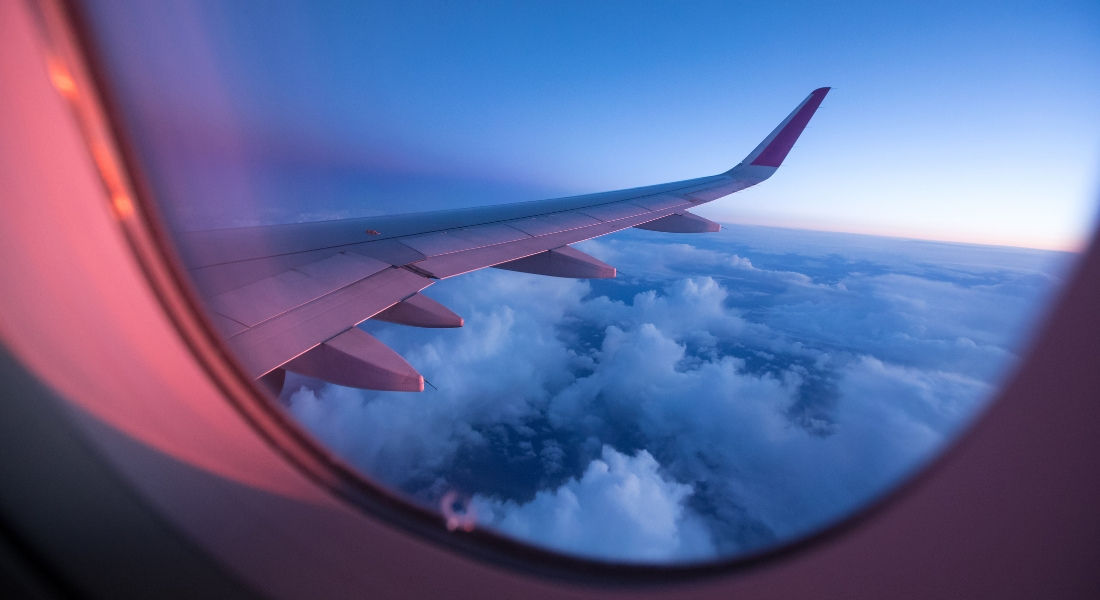
It is already time to hit the road one last time towards Las Vegas to return your vehicle and head to the airport for your flight back, your mind filled with memories of the American West and all its wonders!
That's it! You are all set to hit the great roads of the West. For any questions, feel free to express yourself in the comments section below!











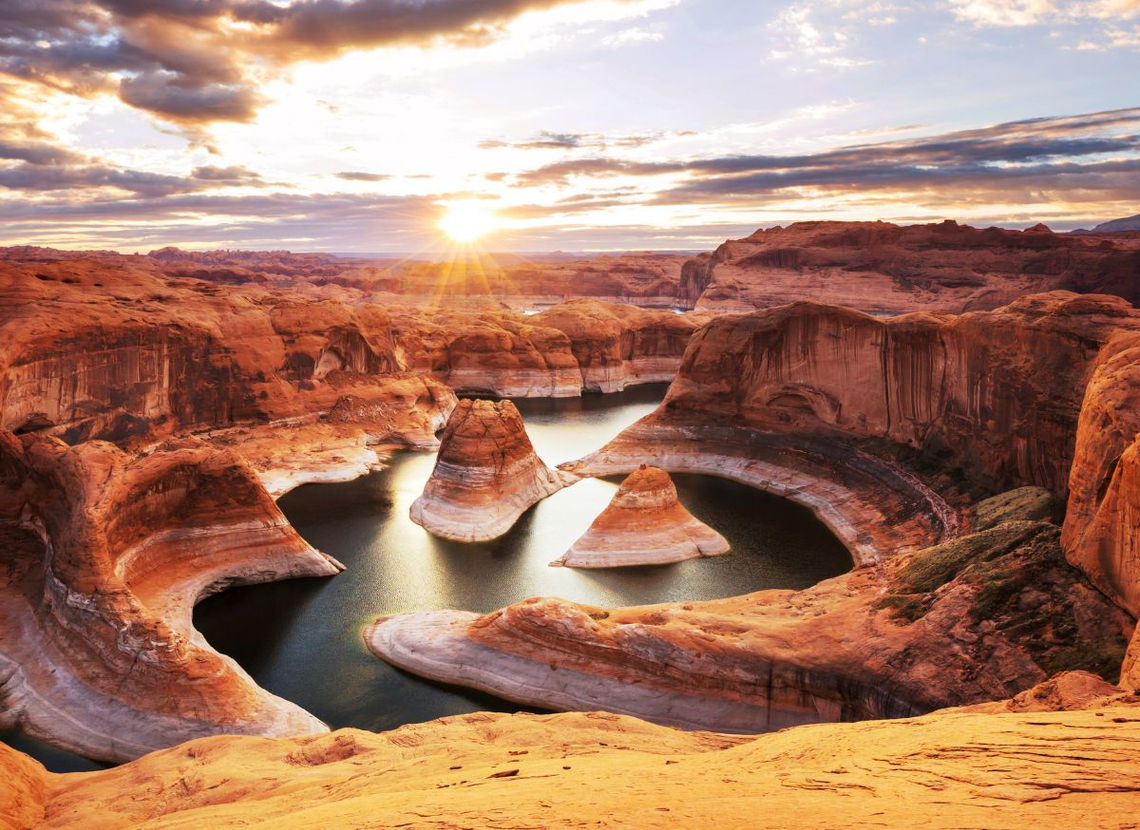
















LEAVE A COMMENT
Répondre à: -
delete my replyYour e-mail address will not be shared
1 comment